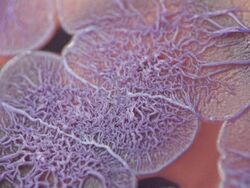Biology:Burkholderia thailandensis
| Burkholderia thailandensis | |
|---|---|

| |
| Burkholderia thailandensis on Ashdown's media | |
| Scientific classification | |
| Domain: | Bacteria |
| Phylum: | Pseudomonadota |
| Class: | Betaproteobacteria |
| Order: | Burkholderiales |
| Family: | Burkholderiaceae |
| Genus: | Burkholderia |
| Species: | B. thailandensis
|
| Binomial name | |
| Burkholderia thailandensis Brett et al. 1998[1]
| |
Burkholderia thailandensis is a nonfermenting motile, Gram-negative bacillus that occurs naturally in soil. It is closely related to Burkholderia pseudomallei, but unlike B. pseudomallei, it only rarely causes disease in humans or animals.[2][3][4][5] The lethal inoculum is approximately 1000 times higher than for B. pseudomallei.[6] It is usually distinguished from B. pseudomallei by its ability to assimilate arabinose.[7] Other differences between these species include lipopolysaccharide composition, colony morphology, and differences in metabolism.[8]
Use in research
Burkholderia thailandensis is sometimes used to model B. pseudomallei infection in mice because of similarities in the immune response.[9][10][11] B. thailandensis does not require biosafety category 3 facilities and is not considered a biosecurity threat, which makes it easier to study and to work with.[12] Burkholderia thailandensis has secondary products that play an essential role in the ecology of soil bacteria.[13] Co-culture studies showed that B. thailandensis strain E264 produces an antimicrobial substance that prevents the growth of other soil bacteria called Bacillus subtilis strain 168.
Small RNA
Research suggests that as in other bacteria, small non coding RNAs play a role in response to the environmental and stress conditions like antibiotic exposure and survival in a host-specific environment.[14] Several small RNA have been discovered in B. thailandenisis: BHT_s1 and BHT_s39 exhibit differential expression profiles dependent on growth phase and cell stimuli, such as antibiotics and serum. BHT_s39 could function in bacterial metabolism and adaptation to host. BTH_s13 and BTH_s19 may regulate expression of their downstream gene.[14]
References
- ↑ "Burkholderia thailandensis sp. nov., a Burkholderia pseudomallei-like species". Int J Syst Bacteriol 48: 317–320. 1998. doi:10.1099/00207713-48-1-317. PMID 9542103.
- ↑ "Biochemical characteristics of clinical and environmental isolates of Burkholderia pseudomallei". J Med Microbiol 45 (6): 408–12. 1996. doi:10.1099/00222615-45-6-408. PMID 8958243.
- ↑ "Arabinose assimilation defines a nonvirulent biotype of Burkholderia pseudomallei". Infect Immun 65 (10): 4319–21. 1997. doi:10.1128/IAI.65.10.4319-4321.1997. PMID 9317042.
- ↑ "Arabinose-positive Burkholderia pseudomallei infection in humans: case report". Clin Infect Dis 28 (4): 927–28. 1999. doi:10.1086/517253. PMID 10825075.
- ↑ "Pneumonia and Septicemia Caused by Burkholderia thailandensis in the United States". J Clin Microbiol 44 (12): 4601–04. 2006. doi:10.1128/JCM.01585-06. PMID 17050819.
- ↑ "Inflammation patterns induced by different Burkholderia species in mice". Cell Microbiol 10 (1): 81–87. 2007. doi:10.1111/j.1462-5822.2007.01016.x. PMID 17645551.
- ↑ "Arabinose assimilation defines a nonvirulent biotype of Burkholderia pseudomallei". Infect Immun 65 (10): 4319–321. 1997. doi:10.1128/IAI.65.10.4319-4321.1997. PMID 9317042.
- ↑ Woods DE (1999). "Species versus Biotype Status". J Clin Microbiol 37 (11): 3786–7. doi:10.1128/JCM.37.11.3786-3787.1999. PMID 10610379.
- ↑ "Inflammation patterns induced by different Burkholderia species in mice". Cell Microbiol 10 (1): 81–7. 2008. doi:10.1111/j.1462-5822.2007.01016.x. PMID 17645551.
- ↑ "Burkholderia thailandensis as a model system for the Study of the virulence-associated type III secretion system of Burkholderia pseudomallei". Infect Immun 76 (11): 5402–11. 2008. doi:10.1128/IAI.00626-08. PMID 18779342.
- ↑ "Differential susceptibility of inbred mouse strains to Burkholderia thailandensis aerosol infection". Microb Pathog 48 (1): 9–17. 2010. doi:10.1016/j.micpath.2009.10.004. PMID 19853031.
- ↑ "Burkholderia thailandensis as a Model System for the Study of the Virulence-Associated Type III Secretion System of Burkholderia pseudomallei". Infect Immun 76 (11): 5402–11. 2008. doi:10.1128/IAI.00626-08. PMID 18779342.
- ↑ Klaus, J. R., Majerczyk, C., Moon, S., Eppler, N. A., Smith, S., Tuma, E., Groleau, M.C., Asfahl, K. L., & Smalley, N. E., Nicole, E., Hayden, H. S., Piochon, M., Ball, P., Dandekar, A. A., Gauthier, C., Deziel, E., Chandler, J. R. (2020). Burkholderia thailandensis methylated hydroxyalkylquinolines: Biosynthesis and antimicrobial activity in cocultures. Applied and Environmental Microbiology, 86(24), 1-17. doi:10.1128/AEM.01452-20
- ↑ 14.0 14.1 Stubben, Chris J.; Micheva-Viteva, Sofiya N.; Shou, Yulin; Buddenborg, Sarah K.; Dunbar, John M.; Hong-Geller, Elizabeth (2014-05-19). "Differential expression of small RNAs from Burkholderia thailandensis in response to varying environmental and stress conditions". BMC Genomics 15 (1): 385. doi:10.1186/1471-2164-15-385. ISSN 1471-2164. PMID 24884623.
External links
Wikidata ☰ Q4999034 entry
 |

